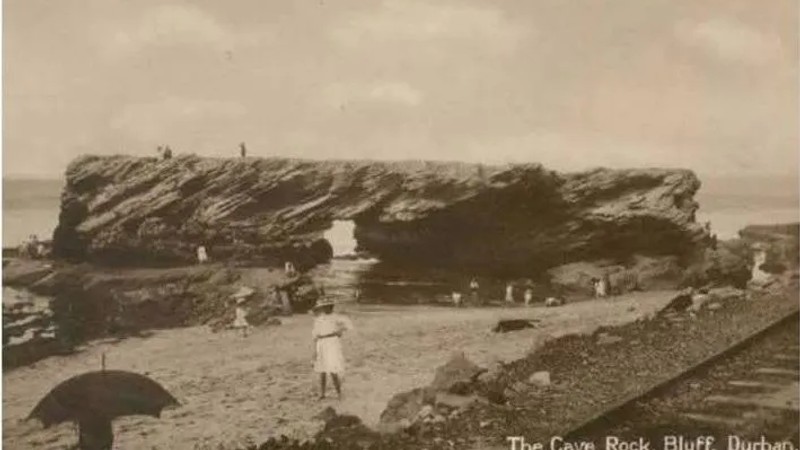The old picture this week features Durban’s Cave Rock, a distinctive and famed swimming, sufing, fishing and picnicking spot just off the headland of the Bluff. The pictures, old and new, were taken from a post by Manny Lutchaman in the Facebook group Durban History and Stories.
Yet many Durbanites will know little about the spot because of an act of philistinism. It was deliberately dynamited in the 1940’s by the South African War Department.
Durban historian and blogger Graham Leslie McCallum describes the decision so eloquently in one of his posts:
“For many hundreds of thousands of years this large sandstone formation stood proudly at the Bluff headland, witnessing the centuries rolling on like the ocean waves. It was there that Christmas Day in 1497 when Vasco da Gama sailed up the coast in his rickety wooden carrack looking for his route to the East. It was standing like a sentinel in 1685 when the sailors of the ironically named ‘Good Hope’ were wrecked at Rio de Natal (Port Natal). They built a hut on the south shore near the outcrop until being rescued the following year.
“Also, familiar with this formation were the tribe called the Abakwa Luthuli ‘People of the Dust’ who used the Bluff as a refuge from King Shaka’s marauding Zulu impi and thus survived his ‘Mfecana’.

“Meticulous mapmaker Lieutenant King would most certainly have recorded it in 1823 during his survey of the Bay and surrounds. It was there in 1824 when 20-year-old settler and pioneer Henry Ogle built his kraals and homestead atop the Bluff.
“And so it was for all those early Durbanites – who could also visit the mound for a look-see, a family picnic and the opportunity to take a scenic photograph. For no citizen of this maritime city considered himself one until he had perched himself like a rooster atop this pile, or had cowered chicken-hearted beneath the the arch of the cave at low tide.
“Like a bulwark it managing to withstand the pounding of a myriad Indian Ocean waves, but not the decision of the pratt who determined that it blocked the trajectory of the gun placed at the headland to protect the Port of Durban from German u-boats during World War 2. Would it not have been easier to simply move the gun emplacement? I hope the name of this person can be ascertained so that it can be established like a monumental adjective to idiocy.”
On the Facebook page David Drew writes that his grandfather was part of the team that blew it up. “It was apparently obscuring the search light which I believe was on the end of the pier. Much to the dismay of his children (a few years later) that had been told stories about the ‘mermaid’ that lived in the cave. And yes the German subs did actually get as far as Durban at one point so perhaps it was necessary. Sad though. Would have been an interesting place to visit.”

